
Italian postcard by Casa Editrice Ballerini & Fratini, no. 16. Photo: United Artists. Alla Nazimova in Salome (Charles Bryant, 1922). Collection: Marlene Pilaete.
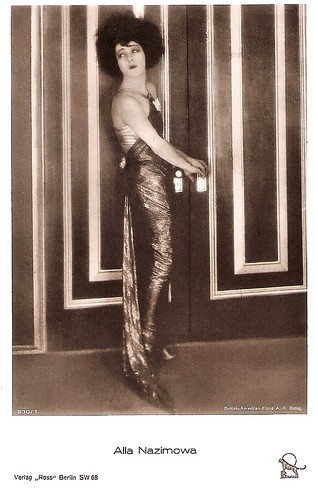
German postcard by Ross Verlag, no. 830/1, 1925-1926. Photo: British-American Films A.G. Balag. Publicity still for Camille (Ray C. Smallwood, 1921).
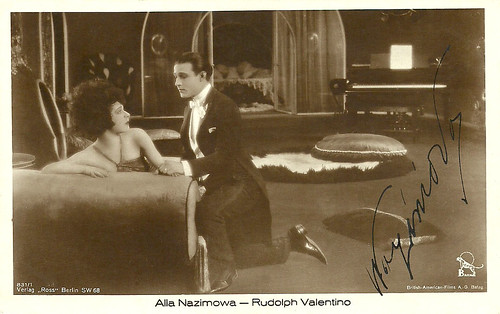
German postcard by Ross Verlag, no. 831/1, 1925-1926. Photo: British American Films / Balag. Collection: Didier Hanson. Publicity still for Camille (Ray C. Smallwood, 1921) with Rudolph Valentino.
Stanislavski
Alla Nazimova (Russian: Алла Назимовa) was born Marem-Ides Leventon (Russian name Adelaida Yakovlevna Leventon) in Yalta, Crimea, Russian Empire, in 1879. She was the youngest of three children of Jewish parents Yakov Abramovich Leventon, a pharmacist, and Sofia (Sara) Lvovna Horowitz, who moved to Yalta in 1870 from Kishinev.
At age 17 Alla Leventon abandoned her training as a violinist and went to Moscow to work in theatre with V.I. Nemirovich-Danchenko. In 1892, she joined Constantin Stanislavski's Moscow Art Theatre using the name of Alla Nazimova for the first time. Her stage name was a combination of Alla (a diminutive of Adelaida) and the surname of Nadezhda Nazimova, the heroine of the Russian novel 'Children of the Streets'.
Nazimova's theatre career blossomed early. In 1899 she married Sergei Golovin, a fellow actor, but they soon separated. Gary Brumburgh at IMDb: “She grew discontented with Stanislavsky and later performed in repertory. She met the legendary Pavel Orlenev, a close friend of Anton Chekhov and Maxim Gorky, and entered into both a personal and professional relationship with him.”
By 1903 she was touring Russian provinces. She also toured Europe, including London and Berlin, with Orlenev. They immigrated to the United States in 1905. He soon returned, but she was signed up by the American producer Henry Miller. Although she spoke not a word of English, she so impressed the Shubert brothers that they hired her on the condition she learn English in six months.
In 1906 she made her Broadway debut in the title role of 'Hedda Gabler' by Henrik Ibsen with critical and popular success. She also played other Ibsen characters: Nora in 'A Doll’s House', Hedwig in 'The Wild Duck', and Hilda in 'The Master Builder'. She quickly became extremely popular and remained a major Broadway star for years.
From 1912 to 1925, Nazimova maintained a ‘fake marriage’ with British actor and director Charles Bryant, who was often her co-star. In order to bolster this arrangement with Bryant, Nazimova kept her marriage to Golovin secret.
Due to her notoriety in a 35-minute 1915 pacifist play entitled 'War Brides', Nazimova made her silent film debut in the film version, War Brides (Herbert Brenon, 1916), which was produced by independent producer Lewis J. Selznick. She made $100,000 touring in War Brides and an additional $60,000 for the film version. The film's lost status makes it now a sought-after title.
In 1917, she negotiated a contract with Metro Pictures, a precursor to MGM, that included a weekly salary of $13,000. She moved from New York to Hollywood, where she made a number of highly successful films for Metro, including a part as a reformed prostitute in Revelation (George D. Baker, 1918), which earned her a considerable amount of money.
Nazimova soon felt confident enough in her abilities to begin producing and writing films in which she also starred. Examples are Eye for Eye (Albert Capellani, 1918), The Brat (Herbert Blache, 1919) and Madame Peacock (Ray C. Smallwood, 1920).
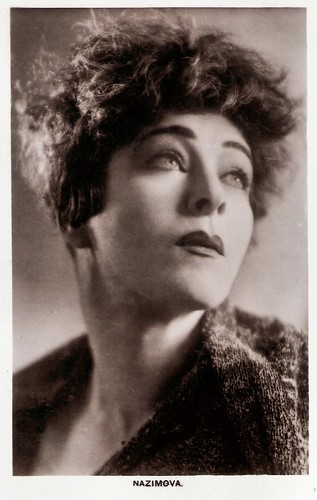
British postcard in the Picturegoer Series, London, no. 203

French postcard, no. 344. Photo: Studio G.L. Manuel Frères. Collection: Didier Hanson.

British postcard in the Pictures Portrait Gallery by Pictures Ltd., no. 174.
Lavish Art Deco sets
Alla Nazimova starred in Camille (Ray C. Smallwood, 1921) as the courtesan Marguerite opposite Rudolph Valentino as her idealistic young lover Armand. Camille is based on the play adaptation 'La Dame aux Camélias' (The Lady of the Camellias) by Alexandre Dumas, fils.
The film was set in 1920s Paris, whereas the original version took place in Paris in the 1840s. It had lavish Art Deco sets and Rudolph Valentino later married the art director, Natacha Rambova. Jennifer Horne at The Women Film Pioneers Project: “Working under contract with Metro Pictures Corporation between late 1917 and April 1921, her company, Nazimova Productions, produced nine largely profitable, feature-length films and brought along the writing talent of writer-producer June Mathis. Details regarding the supervisory roles Nazimova played in the production of many of her films remain confusing since not all of Nazimova’s contributions are reflected in the official credits on films.”
In her film adaptations A Doll's House (Charles Bryant, 1922), based on Henrik Ibsen, and Salomé (Charles Bryant, 1923), based on Oscar Wilde's play, Nazimova developed her own filmmaking techniques, which were considered daring at the time.
Despite the film being only a little over an hour in length and having no real action to speak of, Salomé cost over $350,000 to make. All the sets were constructed indoors to be able to have complete control over the lighting. The film was shot completely in black and white, matching the illustrations done by Aubrey Beardsley in the printed edition of Wilde's play. The costumes, designed by Natacha Rambova, used material only from Maison Lewis of Paris, such as the real silver lamé loincloths worn by the guards.
Both A Doll's House and Salomé were commercial failures. Gary Brumburgh: “The monetary losses she suffered as a producer were astronomical.” Marlene Pilaete adds: "A Doll’s House and Salome were commercial failures but not exactly critical failures, especially A Doll’s House which received mainly positive reviews. The reviews for Salome ranged from favourable to dismissive, which is understandable as it is a much more unconventional movie."
By 1925 Nazimova could no longer afford to invest in more films, and financial backers withdrew their support. Left with few options, she gave up on the film industry. She became an American citizen in 1927.

German postcard by Ross Verlag, Berlin, no. 831/2, 1925-1926. Photo: British-American-Films A.G. (Balag). Publicity still for Camille (Ray C. Smallwood, 1921) with Rudolph Valentino.

Danish postcard by Stenders Kunstforlag, no. 39. Photo: First National Pictures. Publicity still for Madonna of the Streets (Edwin Carewe, 1924) with Milton Sills.

French card by Mon Ciné. The card was a supplement to the magazine Mon Ciné, no. 102, published 3 January 1924.
Outlandish parties at her mansion on Sunset Boulevard
In 1928, Alla Nazimova returned to the Broadway stage as Madame Ranevsky in Eva Le Gallienne’s production of Anton Chekhov’s The Cherry Orchard.
Acclaimed were also her starring roles as Natalya Petrovna in Rouben Mamoulian's 1930 production of Turgenev's 'A Month in the Country', Christine in Eugene O’Neill’s 'Mourning Becomes Electra' (1931), O-Lan in Pearl Buck’s 'The Good Earth' 1932), and as Mrs. Alving in Ibsen's 'Ghosts' (1935).
In the early 1940s, she played character roles in a few more films. She played Robert Taylor's mother who is in a concentration camp in Nazi Germany in Escape (Mervyn Le Roy, 1940) and Tyrone Power's mother in Blood and Sand (Rouben Mamoulian, 1941). Her final film was Since You Went Away (John Cromwell, 1944), an epic about the American home front during World War II.
Nazimova openly conducted relationships with women, and there were outlandish parties at her mansion on Sunset Boulevard, in Hollywood, California, known as ‘The Garden of Alla’. She is credited with having originated the phrase ‘sewing circle’ as a discreet code for lesbian or bisexual actresses.
Nazimova helped start the careers of both of Rudolph Valentino's wives, Jean Acker and Natacha Rambova. Although she was involved in a lesbian affair with Acker, it is debated if Nazimova and Rambova had a sexual affair. Nazimova was impressed by Rambova's skills as an art director, and Rambova designed the innovative sets for her film productions of Camille and Salomé.
Of those Nazimova is confirmed to have been involved romantically, the list includes actress Eva Le Gallienne, director Dorothy Arzner, writer Mercedes de Acosta, and Oscar Wilde's niece, Dolly Wilde. Nazimova lived with Glesca Marshall from 1929 until her death.
In 1945 Alla Nazimova died of coronary thrombosis in a hospital in Los Angeles. She was 66. Gavin Lambert wrote 'Nazimova: A Biography', which was published by Alfred A. Knopf in 1997 and was republished last year in 2021 by the University Press of Kentucky.
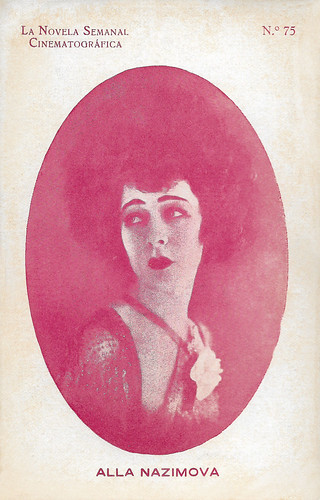
Spanish postcard by La Novela Semanal Cinematografica, no. 75.
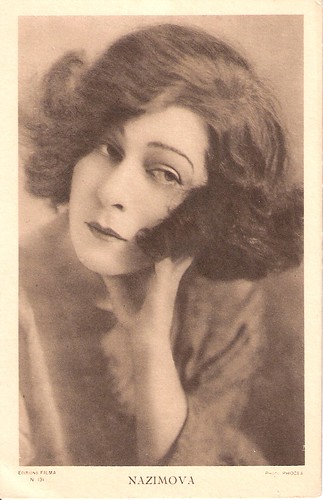
French postcard by Editions Filma, no. 131. Photo: Phocea was a French distributor in the early 1920s, that apparently distributed films with Nazimova in France then.
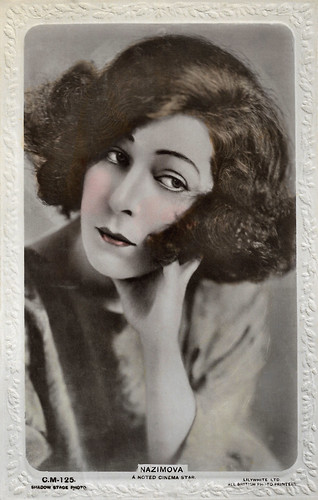
British postcard by Lilywhite Ltd, no. C.M. 125. Caption: Nazimova, A Noted Cinema Star. Sent by mail in 1921.
Sources: Marlene Pilaete (by mail), Jennifer Horne (Women Film Pioneers Project), Gary Brumburgh (IMDb), Sandra Brennan (AllMovie), Encyclopaedia Britannica, Wikipedia and IMDb.
No comments:
Post a Comment